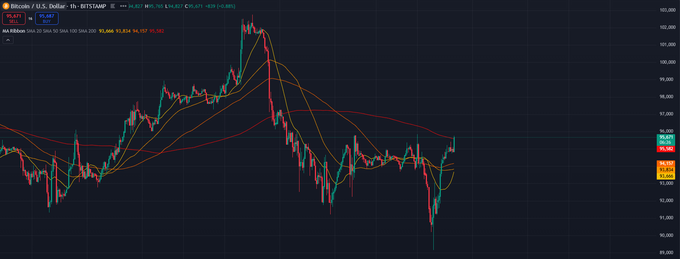Mastering Bitcoin Trading Strategies: A Comprehensive Guide
Crypto trading, particularly Bitcoin trading, is one of the most exciting yet challenging ventures in the financial world. Its volatile markets and dynamic price movements require traders to adopt a well-rounded trading strategy that balances risk management, market analysis, and flexibility. This comprehensive guide is designed to help both novice and seasoned traders navigate the cryptocurrency market and achieve long-term success.
Published January 13, 2025

Understanding Bitcoin Trading Basics
Bitcoin trading involves the buying and selling of Bitcoins with the primary goal of making a profit. To navigate this dynamic market, traders need a basic understanding of how the cryptocurrency market operates and the various factors that influence Bitcoin’s price.
Traders can utilize different platforms, such as exchanges and brokers, to execute their trades. Each platform offers unique features and fee structures, so it’s essential to choose one that aligns with your trading strategy. Understanding the different types of orders is also crucial. Market orders allow for immediate execution at the current market price, while limit orders enable traders to set specific prices at which they are willing to buy or sell.
Additionally, traders should be mindful of the fees associated with trading, including transaction fees and commission fees. These costs can add up and impact overall profitability, so it’s important to factor them into your trading plan. By grasping these basics, you can lay a strong foundation for successful Bitcoin trading.
Understanding the Importance of Round Numbers in Trading
One common mistake in cryptocurrency trading is relying on round numbers for placing orders. For example, setting a buy order at $90,100 may seem logical, but such numbers often attract a significant number of traders, creating market congestion and reducing the likelihood of execution.
Key Strategy: Fine-Tuning Your Trades
Avoid Predictable Levels: Instead of using round numbers, consider placing your buy or sell orders slightly above or below these levels. For instance, $90,150 or $89,950 can increase your chances of successful execution.
Informed Decisions Based on Price Charts: Analyze real-time market analysis and technical indicators, such as support and resistance levels, to identify optimal entry and exit points.
Navigating Market Trends and Fluctuations
Bitcoin’s price movements are influenced by market trends, historical data, and external factors like regulatory news or institutional interest. Predicting price movements requires a deep understanding of these elements.
Can Bitcoin Dip Lower?
As of now, Bitcoin trades at around $95,450, but market conditions could lead to fluctuations. A possible dip to $86,500 might occur depending on market momentum and trader behavior. However, waiting for a perfect drop might cause you to miss out on potential gains.
Pro Tips:
Embrace Swing Trading: Capitalize on short-term market fluctuations without waiting for the “perfect price.”
Leverage Historical Data: Use historical data and technical analysis to predict potential price patterns and market movements.
Technical Analysis: A Crucial Tool for Traders
Technical analysis is indispensable for making informed decisions in cryptocurrency trading. It helps traders identify price patterns, support and resistance levels, and overall market movements.
Essential Technical Indicators:
Candlestick Patterns: Visualize market sentiment and predict price trends.
Moving Averages: Tools like the 50-day and 200-day moving averages can help you identify long-term market trends.
Volume Analysis: Evaluate trading volume to confirm the strength of market movements.
Support and Resistance Levels: Pinpoint crucial levels for setting stop loss orders or determining trading outcomes.
Advanced Trading Techniques
For those looking to take their trading to the next level, advanced trading techniques offer the potential to maximize profits and minimize losses. One such technique is technical analysis, which involves using charts and indicators to predict price movements. By analyzing patterns and trends, traders can make more informed decisions about when to enter or exit a trade.
Fundamental analysis is another powerful tool, focusing on the underlying value and growth potential of a cryptocurrency. This approach involves evaluating factors such as technological advancements, market demand, and regulatory developments to gauge a cryptocurrency’s long-term prospects.
Programmatic trading, or algorithmic trading, is an advanced technique where traders use algorithms to execute trades automatically based on predefined criteria. This method can help eliminate emotional biases and ensure consistent execution of trading strategies.
Risk management remains a cornerstone of advanced trading. Techniques such as stop-loss orders and position sizing are essential for protecting your capital and ensuring sustainable trading outcomes. By mastering these advanced techniques, traders can enhance their ability to predict price movements and navigate the complexities of the cryptocurrency market.
Risk Management: The Foundation of Long-Term Success
Effective risk management is critical for navigating volatile markets and limiting potential losses. Without proper safeguards, even a single trade can significantly impact your portfolio.
Strategies to Limit Potential Losses:
Position Sizing: Allocate a specific portion of your portfolio for each trade, ensuring you never risk more than you can afford to lose.
Stop Loss Orders: Use these to automatically exit a trade if the market moves against you, protecting your gains and limiting losses.
Market Analysis and Insights
Effective market analysis is key to making informed trading decisions. By studying market trends and fluctuations, traders can gain valuable insights into potential price movements. Tools such as price charts and technical indicators are indispensable for analyzing the market. These tools help traders identify patterns, support and resistance levels, and overall market sentiment.
Understanding market sentiment and investor psychology is also crucial. Factors such as news events, regulatory changes, and institutional interest can significantly impact Bitcoin’s price. Staying up-to-date with market news and events allows traders to anticipate market movements and adjust their strategies accordingly.
Historical data analysis provides another layer of insight. By examining past market trends and patterns, traders can identify potential future movements and make more informed predictions. Combining these analytical tools and insights can help traders navigate the volatile cryptocurrency market with greater confidence.
Day Trading vs. Long-Term Trading
The cryptocurrency market offers opportunities for both quick trades (day trading) and longer-term investments.
Day Trading:
Focus on quick decisions and small profits over multiple trades.
Requires tools for real-time market analysis and a keen understanding of market volatility.
Long-Term Success:
Analyze market trends and maintain discipline for steady portfolio growth.
Ideal for traders who prefer minimizing frequent decision-making and focusing on larger gains over time.
Trading Psychology and Discipline
Successful trading goes beyond technical skills; it also involves mastering the psychological aspects of trading. Trading psychology focuses on understanding the emotional and psychological factors that influence trading decisions. Emotions such as fear and greed can lead to impulsive decisions and negatively impact trading outcomes.
Discipline is essential for maintaining a consistent and effective trading strategy. This involves sticking to a well-defined trading plan and avoiding impulsive decisions based on short-term market movements. Effective risk management and position sizing are also critical components of disciplined trading.
Developing a trading mindset that prioritizes long-term success over short-term gains is crucial. This mindset helps traders stay focused on their overall goals and avoid the pitfalls of emotional trading. By cultivating discipline and a strong trading psychology, traders can improve their decision-making and achieve more consistent results in the volatile world of Bitcoin trading.
Position Sizing and Management
Position sizing is a critical aspect of trading that involves determining the optimal amount of capital to allocate to each trade. Factors such as risk tolerance, market volatility, and potential profit should be considered when determining position size. Proper position sizing helps manage risk and ensures that no single trade can significantly impact your portfolio.
Position management involves adjusting the size of a trade based on market conditions and trading outcomes. This may include scaling in or out of positions as the market moves in your favor or against you. Stop-loss orders and take-profit points are essential tools for managing positions. These orders help protect your capital by automatically closing trades at predetermined levels.
Regularly reviewing and adjusting your trading strategies is also essential for successful position sizing and management. By staying flexible and adapting to changing market conditions, traders can optimize their position sizes and improve their overall trading outcomes.
Sharing Insights and Tools for Success
Successful Bitcoin trading involves sharing insights and leveraging tools that simplify decision-making. Platforms like Broker Reviews provide resources for technical analysis, market updates, and strategies tailored to the cryptocurrency market.
Recommended Tools:
Real-Time Market Analysis Tools: Stay updated on market conditions to make informed trades.
Educational Resources: Enhance your knowledge of price charts, technical indicators, and trading strategies.
Conclusion: Balancing Strategy and Flexibility
Mastering Bitcoin trading requires balancing a well-thought-out strategy with the ability to adapt to market fluctuations. While predicting exact price movements can be challenging, understanding market conditions, leveraging technical analysis, and managing risk can help traders achieve consistent gains.
At Broker Reviews, we aim to empower traders with the tools and insights needed to thrive in the cryptocurrency market. Visit our site for more comprehensive guides, trading strategies, and resources designed to enhance your trading outcomes.
Remember: The goal is not to win every trade but to build a sustainable approach that delivers long-term success in the volatile cryptocurrency market.






